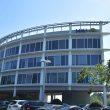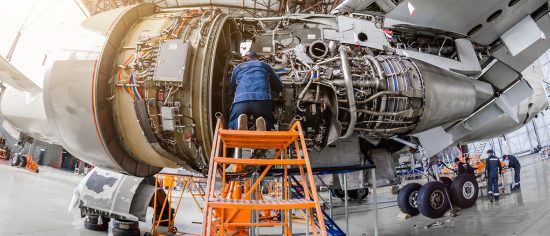Topics Under Article Hide
- What does an aerospace engineers do?
- Where do aerospace engineers work?
- What kind of income does an aerospace engineer receive?
- Aerospace Engineering: Required Skill Set
- Aerospace Engineering Eligibility Criteria
- Aerospace Engineering Syllabus
- Aerospace Engineering Job Profiles
- Aerospace Engineering Top Recruiters
- Difference between Aerospace and Aeronautical Engineering
- Eligibility Criteria of Aerospace Engineering
- Scope of Aerospace Engineering
- Course Fees Aerospace Engineering
- Course Subjects
- Syllabus for M.Tech in Aerospace Engineering
- Careers in Aerospace Engineering
- Certifications for Aerospace Engineering
- Job Profiles and Top Recruiters
- Average Salary
- Firms of U.S. that Employ International Student
Aerospace engineering is the foremost discipline of engineering anxious with the development, testing, design, and manufacturing of aircraft, spacecraft, and associated structures and equipment. The discipline has historically centered on issues associated with atmospheric and area flight, with principal and overlapping branches: aeronautical engineering and astronautical engineering.
Aeronautical Engineering makes a specialty of the theory, era, and exercise of flight inside the earth’s atmosphere.
Astronautically Engineering makes a specialty of the technological know-how and era of spacecraft and release vehicles.
Contents
- 0.1 What does an aerospace engineers do?
- 0.2 Where do aerospace engineers work?
- 0.3 What kind of income does an aerospace engineer receive?
- 0.4 Aerospace Engineering: Required Skill Set
- 0.5 Aerospace Engineering Eligibility Criteria
- 0.6 Aerospace Engineering Syllabus
- 0.7 Aerospace Engineering Job Profiles
- 0.8 Aerospace Engineering Top Recruiters
- 0.9 Difference between Aerospace and Aeronautical Engineering
- 0.10 Eligibility Criteria of Aerospace Engineering
- 0.11 Scope of Aerospace Engineering
- 0.12 Course Fees Aerospace Engineering
- 0.13 Course Subjects
- 0.14 Syllabus for M.Tech in Aerospace Engineering
- 0.15 Careers in Aerospace Engineering
- 0.16 Certifications for Aerospace Engineering
- 0.17 Job Profiles and Top Recruiters
- 0.18 Average Salary
- 1 Firms of U.S. that Employ International Student
What does an aerospace engineers do?
It broaden current technology and combine them into aerospace car structures used for transportation, communications, exploration, and protection applications. This includes the layout and production of plane, spacecraft, propulsion structures, satellites, and missiles, in addition to the layout and checking out of plane and aerospace products, components, and subassemblies. Successful aerospace engineers own in-intensity abilities in, and an knowledge of, aerodynamics, substances and structures, propulsion, car dynamics and control, and software.
Where do aerospace engineers work?
Aerospace engineer’s paintings generally within the aerospace industry, at authorities labs, structures & software program suppliers, company labs, and universities. The capability set of aerospace engineers is amazingly enormous and multidisciplinary, and the revel in of aerospace engineers as structures architects and engineers permits them to build a contribution in lots of frequent sectors.
The Bureau of Labor Statistics, provides the industries that engaged nearly all aerospace engineers in 2016 that were given below:
- Engineering services: 15%
- Aerospace product and parts manufacturing: 40%
- Federal government, excluding postal service: 15%
- Research & development in the engineering, physical, and life sciences: 14%
- Measuring, electro medical, Navigational and control instruments manufacturing: 7%
In 2016, and for the fourth time in six years, Penn State crowned the listing of desired providers of engineering expertise to the aerospace and protection industry, in line with the Aviation Week 2016 Workforce Study.
Also Check Masters in Engineering Management in Germany
What kind of income does an aerospace engineer receive?
According to the Bureau of Labor Statistics, the median annual salary for aerospace engineers was $105,380 in May 2015. The median annual wages for aerospace engineers withinside the pinnacle industries wherein they labored had been as follows:
- Engineering services = $103,460
- Aerospace product and parts manufacturing = $102,445
- Federal government, excluding postal service = $113,575
- Navigational, measuring, electro medical, and control instruments manufacturing = $111,665
- Research and development in the physical, engineering, and life sciences = $107,500
The standard yearly starting income for Penn State Aerospace Engineering 2017-2018 undergraduates was $63,289.
Aerospace Engineering is a department of Engineering that gives competencies and know-how to design, manufacture and keep spacecrafts, aircrafts, missiles and guns systems. A huge a part of Aerospace Engineering includes Mechanical Engineering protecting an extensive variety of topics, which includes laptop application, structures, mathematics, physics, drafting, electricity, robotics, aeronautics etc.
It additionally covers elements of engineering, specifically Aeronautical Engineering and Astronomical Engineering. Aerospace Engineering is taken into deliberation to several of the hardest branches of engineering that has imprinted its region of interest some of the students.
However, as soon as finished this path gives ‘wings’ for your profession taking it to new heights. Here’s an outline of Aerospace Engineering for aspirants who desire to make a profession on this field. Also check Aerospace Engineering fee in India .

Aerospace Engineering: Required Skill Set
Aerospace Engineering is an outstandingly dedicated technical region that calls for standard brilliance in mathematical, calculative and observational abilities. Research on this area takes years to be finished thus, resilience and staying power is important. Here are some vital qualities/abilities you’ll require to be a success Aerospace Engineer:
| Required Skill Set For Aerospace Engineering | |
| Excellent scholastic background in Science stream | Strong methodical and mathematical skills |
| Creativity & innovativeness in specific product designing | Eye for detail |
| Capability to work under pressure and for long hours | Scientific acumen |
| Physical stamina | Capability to labor in a group and be able to lead a team |
Aerospace Engineering Eligibility Criteria
An Aerospace Engineering aspirant has to meet the minimal eligibility standards so that it will pursue the course. Check the minimal eligibility standards for Aerospace Engineering below:
• Least eligibility standards for pursuing Aerospace Engineering is passing superior secondary or Class 12 with at the very least 62 in step with cent marks (56 in step with cent marks for SC/ST) in Science stream (PCM)
• Aerospace Engineering is maximum of the diploma publications are presented at post-graduate level. For this, the candidate is needed to have 60 in step with cent marks (fifty five in step with cent marks for SC/ST) in Bachelor’s diploma (BE/B Tech or equivalent)
• For admission to post-graduate and Doctoral programmes and research, GATE rating is needed
• Candidates with three-4 yr diploma in Engineering, technical diploma, five-yr Architecture, Postgraduates in Mathematics/Science/Statistics/Computer Applications also are eligible to pursue Aerospace Engineering
• If one aspires to enroll in National Aeronautics and Space Administration (NASA) withinside the United States (US), they have to be knowledgeable that NASA recommends a diploma in a whole lot of disciplines, consisting of Biomedical Engineering, Ceramic Engineering, Chemistry, Industrial Engineering, Materials Engineering, Metallurgy, Optical Engineering, and Oceanography. PhD is tremendously endorsed for folks that need to enroll in NASA.
Aerospace Engineering Syllabus
The Aerospace Engineering programme is largely a BTech programme that is unfold over 4 educational years. Any Aerospace Engineering path accommodates the subsequent subjects/topics:
| Aerospace Engineering: Syllabus | |
| Aerodynamics | Flight Mechanics |
| Aerospace Propulsion | Incompressible Fluid Mechanics |
| Aerospace Structural Mechanics | Introduction to Aerospace Engineering |
| Aircraft Design | Spaceflight Mechanics |
| Aircraft Propulsion | Thermodynamics and Propulsion |
Aerospace Engineering Job Profiles
Aerospace Engineers design aircraft, spacecraft, missiles and weapons systems. In count, they are also accountable for maintaining, assembling, and ensuring they function correctly at every time. Some focus in additional significant equipment like guidance control systems, air guidance systems, propulsions, and many more.
Duties of an Aerospace Engineer include:
- Assembling, Designing, and testing of aircraft & aerospace goods
- Assessing cost and probability of fresh projects proposed to be undertaken
- Developing new technologies for use in spacecraft, aviation and defense systems
- Manufacturing aircraft and personality mechanism in synchronization with the design team.
- Observe harm or go wrong in an equipment to discover our probable reason and present solution
- Evaluating that the project or the product meets safety norms, engineering principles, customer necessities and environmental challenges
- Determining quality standard receiving criteria for quality standards,design methods, sustainment after delivery, and conclusion dates
• Aerospace Engineers tackle specialized regions of functioning which includes software program engineering, structural engineering, mechanical engineering, electric and digital engineering, for automation and steerage purposes, aerodynamics or propulsion systems.
Aerospace Engineers specialize in mainly 2 types of Engineering: Aeronautical and Astronomical.
Aeronautical Engineer: An Aeronautical Engineer mechanism on aircrafts and its apparatus.
Astronomical Engineer: An Astronomical Engineer works purposely on spacecraft and connected technologies.
Aerospace Engineering Top Recruiters
It is an increasingly developing field, adopting latest technology for additional development in production and functioning of aircrafts and spacecrafts. Previous the space was dominated by government organizations, but with the entrance of a lot of private players, opportunities in this industry are growing more and many more. Given below are a little organizations that hire Aerospace Engineers in a variety of capacities.
- Hindustan Aeronautical Limited (HAL)
- National Aerospace Laboratories (NAL)
- Indian Space Research Organisations (ISRO)
- Defence Research And Development Organisation (DRDO)
Private companies that appoint Aerospace Engineers for their aircraft connected projects like: Boeing, Airbus, Goodrich, GE.
Difference between Aerospace and Aeronautical Engineering
In little, it is a branch of engineering that has two sub-branches. One
is aeronautical engineering, and an additional one is astronautically engineering. Both are
based on the reasonable approach of learning and putting theories into practice; however, when distinguishing between aeronautical and aerospace, significant differences are noticed.
Common Areas
To begin making experience of each the fundamental and the sub-specialization, it’s desirable first of all the similarities. The foremost one is the focus in their studies, that is flight. Both regions look at flight stability, aerodynamics and plane control, in addition to conventional engineering issues. Engineers in each branches generally have a bachelor’s diploma in mechanical, laptop or electric engineering earlier than pursuing a better diploma in computational mechanics or area engineering.
Aerospace Engineering
Aerospace engineering includes designing and growing civil aircraft, their maintenance, building, and checking out of missiles, rockets, area shuttles, area stations, and all different associated units. It’s nearly the wider component comprising numerous smaller fields of engineering.
Aerospace Engineering consists of numerous thrilling topics which are given below:
- Introduction to the field of Aeronautics
- Fundamental Principles related to jet propulsion
- Dynamics of spacecraft beginning to Orbital Mechanics
- Designing of aircraft, missiles, spacecraft, or space stations
Aeronautical Engineering
Aeronautical engineering has a tendency to recognition on flight and sports inside an atmosphere, a greater devoted discipline of aerospace research that generally consists of the atmosphere, however additionally extends into programs in space, wherein there may be no atmosphere. Aeronautical engineering is the exercise of designing and constructing aircraft, like airplanes and helicopters. Students incomes a diploma in aeronautical engineering take lessons like:
- Heat Transfer
- Flight Mechanics
- Thermodynamics
- Aircraft Structures
- Aircraft Stability and Control
The responsibilities of those engineers additionally revolve round assembly with clients, reviewing layout proposals, figuring out the price of production, appearing exams to evaluate the protection of aircrafts, analyzing product overall performance issues, recommending solutions, and most significantly figuring out a way to limit environmental harm from aircraft. At ESiLV engineering school, the publications use modelling and virtual simulation gear for the duration of the research and projects, at the same time as exploring on the equal time the financial and human dimensions of those projects.
Eligibility Criteria of Aerospace Engineering
Eligibility Criteria for Aerospace Engineering
Diploma in Aerospace Engineering: Candidates must byskip elegance tenth examination with technological know-how and math because the obligatory subjects. Students have to have 50% marks for the overall class and forty five percentage marks for the reserved class.
B.Tech in Aerospace Engineering: The primary academic standards calls for passing elegance XII or better secondary in technology circulation with no less than 60% marks for widespread class and 55% for the reserved ones. They also are required to seem for the doorway examination like JEE Main and JEE Advanced.
M.Tech in Aerospace Engineering: Candidates want to qualify their Bachelors diploma in B.Tech/ B.E. in Aerospace Engineering with minimal 60% marks for trendy class and 55% marks for the reserved class. Also, aspirants want to seem and qualify GATE to be able to get admission into most appropriate institutes like IITs.
Admission Process for Aerospace Engineering
- For Diploma in Aerospace Engineering: Most institutes admit the scholars primarily based totally on their overall performance in applicable front exams. Admission method usually varies throughout colleges. A few institutes additionally offer direct admission to the scholars primarily based totally on their overall performance in magnificence X.
- For B.Tech in Aerospace Engineering: There are styles of strategies that applicants can choose to get admission in B.Tech Aerospace Engineering: front examinations (JEE Main and JEE Advanced) or direct admission. To get admission withinside the predominant institutes of India, candidates want to qualify front checks along with JEE Main and JEE Advanced. Direct admission is accomplished on the premise of the marks scored with the aid of using college students in elegance 12th.
- For M.Tech in Aerospace Engineering: Aspirants are required to have a Bachelor’s diploma in B.Tech aerospace engineering with a minimal combination of 60%. Direct admission in IITs (Indian Institute of Technology) is regulated on the idea of marks carried out with the aid of using applicants in GATE.
College Predictors
Scope of Aerospace Engineering
Students choosing Aerospace Engineering have a vivid destiny each in India and Abroad. With some of non-public businesses and development moving into aerospace technology, the possibilities are becoming larger and better. Following are the process possibilities for an aerospace engineer:
1. Most of the aerospace engineers are employed through ISRO (Indian Space Research Organisation)
2. Also candidates are provided jobs in prominent businesses such as- Civil Aviation Department, Hindustan Aeronautics Limited, National Aeronautical Laboratory, Defence Research and Development Laboratory.
3. Jobs are to be had with the national, international, public and personal Airlines Services in addition to plane production units.
Course Fees Aerospace Engineering
| Minimum Fees | Maximum Fees | |||
| Private | Government | Private | Government | |
| UG | 88.24 K | 1.71 Lakhs | 17.25 Lakhs | 11.36 Lakhs |
| PG | 60.00 K | 15.00 K | 8.00 Lakhs | 2.15 Lakhs |
| DOCTORAL | 1.80 Lakhs | — | 5.04 Lakhs | — |
| DIPLOMA | — | 54.00 K | — | 60.00 K |
Course Subjects
Aerospace Engineering Subjects & Syllabus
Listed below is the course and syllabus :
Syllabus for Diploma in Aerospace Engineering
- Aircraft instrumentation system
- CAR (civil aviation regulation)
- Aircraft maintenance and practice
- Aircraft system
- Aircraft structure
- Avionics and aircraft radio system
- Aircraft structures servicing lab
- Maintenance management
- C- Programming lab
- Avionics lab
- Aircraft system servicing lab
- Project work (working model)
- Aircraft electrical system
- Aircraft instrument system lab
- Aircraft materials
- Applied mathematics
- Applied science
- Basic aerodynamics
- Basic computer skills lab
- Basic electrical and electronic engineering
- Basic electrical and electronic engineering labs
- Basic workshop practicals
- Computer aided engineering graphics
- Engineering graphics (conventional)
- English communication
- Fluid mech and pneumatics lab
- Industrial visit
- ISAP lab
- Jet engine lab
- Jet engine theory
- Materials testing (NDT) process lab
- Organizational management
- Piston engine lab
- Piston engine theory
- Fluid mech and pneumatics aircraft inspection and documentation
Syllabus of B.Tech in Aerospace Engineering
Semester 1
- Engineering Mathematics I
- Engineering Physics
- Engineering Chemistry and Environmental Studies
- Engineering Mechanics
- Engineering Graphics
- Basic Civil Engineering
- Basic Mechanical Engineering
- Basic Electrical Engineering
- Basic Electronics Engineering & Information Technology
- Mechanical Workshop
- Electrical and Civil Workshop
Semester 2
- Engineering Mathematics II
- Economics and Communication Skills
- Fluid Mechanics
- Basic Thermodynamics
- Elements of Aeronautics
- Basic Strength of Materials
- Basic Strength of Materials Lab
- Fluid Mechanics Lab
Semester 3
- Engineering Mathematics II
- Economics and Communication Skills
- Fluid Mechanics
- Basic Thermodynamics
- Elements of Aeronautics
- Basic Strength of Materials
- Basic Strength of Materials Lab
- Fluid Mechanics Lab
Semester 4
- Engineering Mathematics III
- Gas Dynamics
- Propulsion I
- Aerodynamics I
- Aircraft Structure I
- Electrical Technology and Machines
- Structures Lab
- Propulsion Lab
Semester 5
- Engineering Mathematics IV
- Principle of Management
- Computer of Programming
- Flight Dynamics I
- Aerodynamics II
- Propulsion II
- Wind Tunnel Lab
- Propulsion Lab II
Semester 6
- Avionics
- Experimental Aerodynamics
- Aircraft Structure II
- Heat Transfer
- Theory of Vibration
- Elective I
- Heat Engines Lab
- Aero Engines lab
Semester 7
- Elective II
- Aircraft Design
- Vibration Lab
- Computational Fluid Dynamics
- Experimental Stress Analysis
- Fight Dynamics II
- Aircraft System and Instrumentation
- Experimental Stress Analysis Lab
- Seminar
- Project
Semester 8
- Elective III
- Elective IV
- Project
- Rocket Missiles
- Introduction to space technology
- Air Transportation and Aircraft maintenance
- Aerodynamics Lab
- Viva Voce
Syllabus for M.Tech in Aerospace Engineering
Semester 1
- Introduction to Space Technology
- Engineering Aerodynamics & Flight Mechanics++
- Elements of Gas Dynamics & Propulsion++
- Airplane and Aerospace Structures++
- Laboratory I
- PG Elective

Semester 2
- Elective I
- Elective II
- Elective III
- Elective IV
- Laboratory II (Str. Lab)
- Aerodynamic Design
Semester 3
- Elective V
- Elective VI
- Elective VII
- Project
- Structural Design
Semester 4
- Project
Careers in Aerospace Engineering
Aerospace Engineering graduates have plenty of profession options. The subject permits graduates to discover sizable horizons. Aeronautical Engineers are in call for each in India and overseas. Moreover, non-public and public Airline Services and aircraft-production devices also are continuously searching out for those graduates. However, initially, college students who pursue Aerospace engineering are employed as graduate engineer trainees or Junior Engineers. Later on, with experience, primarily based totally on their overall performance they’re similarly promoted to the designation. If we cross with the aid of using the reports, it shows that employment of Aerospace Engineers will develop six percentage from 2016 to 2026.
Certifications for Aerospace Engineering
- Certificate in Aeroelasticity
- Certificate Linear & Non linear Modeling
- Certificate in FEA and ANSYS
- Professional Simulation Engineer
- Certificate in Gas Turbine Engineering
- Computational Fluid Dynamics & Training Certificate
Job Profiles and Top Recruiters
An aerospace engineer analyzes, tests, designs, troubleshoots and develops higher era in spacecraft, defense structures and aviation. They expand the requirements for first-class manipulate and layout processes, perceive troubles for merchandise that aren’t running well and attempt to locate answers to repair the ones troubles. Following is the listing of task profile a Aerospace Engineer can decide for:
| Job Profile | Job Description |
| Aerospace Designer Checker | Their job is to investigate, examine and create structural engineering specifications using metallic & non-metallic mechanism. |
| Aircraft Production Manager | Responsibilities comprise of supervising and coordinating well-organized aircraft production lines and making certain that the aircrafts are as per industry and safety principles. |
| Mechanical Design Engineer | They review condition and other related data to increase mechanical layouts. They also calculate physical dimensions for machinery and monitor production lines. |
| Assistant Technical Officer | Work errands comprise cleaning and maintenance of aseptic units and equipment on an everyday or weekly or monthly basis. |
| Aerospace Engineer | They research in diverse ways to make fuel well-organized parts and engines. They carry out ground level testing and guess project cost with time scales. |
Top Recruiters
- Air India
- Defense Research and Development Laboratories
- Civil Aviation Department
- Aeronautical Development Establishment
- National Aeronautical Lab (NAL)
- Pawan Hans
- Helicopter Corporation of India
- Hindustan Aeronautical Ltd (HAL)
- Private Airlines
- Indian Air Force
Duties and Responsibilities of Aerospace Engineers:
- Provide technical advice
- Analyze and interpret data
- Do theoretical and practical research
- Ensure design meet customer requirements
- Work towards completion dates and deadlines
- Assess proposals and design requirements
- Determine if projects are technically and financially realistic
- Go more than budgets, timescales and condition with customers
- Coordinate, direct, manufacture and test procedures, produce and implement design
- Calculate and advance performance of aircraft, systems and mechanism
Average Salary
An aerospace engineer earns a superior figure of though, income, the salary quantity may boost with experience and expertise in skills. Given below is the list of job profiles and their standard salary:
| Job Profile | Average Salary |
| Aerospace Designer Checker | Rs. 30.2 lakhs – Rs. 50.5 lakhs per annum |
| Aircraft Production Manager | Rs. 30.2 lakhs – Rs. 35.3 lakhs per annum |
| Mechanical Design Engineer | Rs. 30.2 lakhs per annum |
| Assistant Technical Officer | Rs. 36 lakhs per annum |
| Aerospace Engineer | Rs. 36 lakhs – Rs. 42 lakhs per annum |
Firms of U.S. that Employ International Student
Many global students that come to study in the United States (US) chase an MS in Aerospace Engineering.
• Aerospace Engineers normally manage with the design of area crafts, aircrafts, satellites and missiles.
• In calculation, they take a glance at prototypes to make convinced that they characteristic in line with design.
How Can One Find a Job in Aerospace Engineering?
Discovering a job in this industry in the U.S. can be hard for a global student on an F1 Visa or J1 Visa.
• The U.S. Government controls exports of touchy equipment, software program and generation as a way to sell countrywide protection pastimes and overseas coverage objectives.
• Most of the Aerospace Engineering enterprise falls beneath this export influence gadget because of their paintings in military, region and aviation.
• In phrases of the realistic impact of this to locating a process, maximum corporations and/or jobs would require that a candidate be a U.S. Citizen or inexperienced card holder and the process would require a protection clearance.
• Thus, it could be tough for a overseas countrywide to be eligible for employment inside the enterprise.
• Right here aren’t a lot of positions to be had though if a worldwide pupil stays dedicated and does all they are able to to split themselves from their peers, they’ll be capable of land a coveted activity at a U.S. firm.
• If an global pupil has super grades and the proper credentials, corporations will make an effort and locate them a spot.
What Firms Hire International Student Aerospace Engineers?
Various firms that hire international students are given below:
- C & D Zodiac
- Zodiac Seats US
- Rockwell Collins
- Gulfstream Aerospace
- The Boeing Company
- Honeywell International
- Cessna Aircraft Company
- Airbus Americas Engineering
- Recaro Aircraft Seating Americas
- Space Exploration Technologies (SpaceX)
What Other Options are There?
There are many instances of international students acquiring an internship at a smaller firm within the Aerospace Engineering industry and then working their way up to opportunities at larger companies.
• There are masses of small plane production agencies withinside the U.S.
• These agencies make light, sports activities aircrafts for non-public use and small businesses, and for that reason do now no longer complete beneathneath the export manage machine and do now no longer have the necessities of being a everlasting resident to paintings for them.
- • However, the Aerospace Engineering enterprise withinside the U.S. isn’t the most effective alternative for an worldwide scholar reading withinside the U.S. Many go back to their domestic united states and searching for employment there.
- • In many countries, the aerospace region is increasing and for that reason the cost of getting a U.S. diploma in that area may be profitable and provide employment opportunity.
What If an International Student Can’t Get an Aerospace Engineering Job?
• Gaining an MS in Aerospace Engineering is a good diploma and plenty of worldwide college students locate that they are able to locate employment in different industries, which include automobile or industrial car settings.
• Joining the monetary enterprise as an analyst may be an possibility as well.
• Financial corporations are usually seeking out talented, clever people, and do now no longer always restrict their seek to people with enterprise backgrounds.
Another option for international students is to continue their studies within the Aerospace Engineering field by pursuing a PhD after their MS.
• This might also additionally deliver an worldwide scholar the possibility to acquire a inexperienced card beneathneath the EB-1.
• For extra records approximately the EB-1, please go to Employment-Based Immigration: First Preference EB-1.
• This calls for publishing papers in esteemed journals and leaping thru fewer hoops than the Employment-Based Immigration: Second Preference EB-2 a good way to have an extended wait line.
An international student pursuing an MS in Aerospace Engineering does have options in attaining employment after graduating.
• While it’s far tough for a overseas country wide to be hired with the aid of using many corporations and roles in the enterprise because of the export manipulate device and safety clearance, there are a few corporations that rent global students.
• With a diploma from a U.S. institution, locating a process returned domestic withinside the aerospace region may be a beneficial option, too.
• Companies within side the U.S. don’t always rent immediately from ranges that our applicable to their enterprise and due to the fact an MS in Aerospace Engineering is a good diploma, graduates can frequently discover possibilities in exclusive industries.







